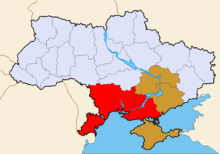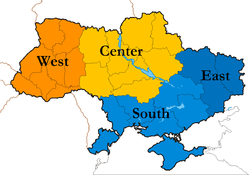Southern Ukraine

Southern Ukraine (Ukrainian: Південна Україна, Pivdenna Ukrayina) refers, generally, to the territories in the South of Ukraine.
The territory usually corresponds with the Soviet economical district, the Southern Economical District of Ukrainian SSR. The region is completely integrated with a marine and shipbuilding industry.
Historical background
The region primarily corresponds to the former Kherson, Taurida, and most of the Yekaterinoslav Governorates which spanned across the northern coast of Black Sea after the Russian-Ottoman Wars of 1768–74 and 1787–92.
Upon dissolution of the Golden Horde, the Pontic steppes (also known as Wild Fields) ended up under the control of Crimean Khanate and smaller nomadic Noghai hordes. At the same time all Genoese and Byzantine strongholds were taken over by the Ottoman Empire.
In 16-17th centuries there appeared a military-oriented community of Cossacks. At the same time there existed endless conflict between main opponents in the region, the Polish-Lithuanian Commonwealth, the Crimean Khanate with the Ottoman Empire, and the Tsardom of Muscovy. In 17th century a new full scale war ensued between Cossacks and the Polish magnates. Later to that war became involved the same opponents the Ottoman Empire, the Tsardom of Muscovy as well as other such as the Kingdom of Sweden. By the 18th century borders in the region stabilized relatively with most of the step being controlled by the Ottoman Empire through their vassals.
Cultural background
Russian is the dominant language in the region (in the schools of the Ukrainian SSR learning Ukrainian was mandatory), although not to the extent that it is in the three oblasts that comprise Eastern Ukraine.[1] Effective in August 2012, a new law on regional languages entitles any local language spoken by at least a 10% minority be declared official within that area.[2] Within weeks Russian was declared as a regional language in several southern and eastern oblasts and cities.[3] Russian could then be used in these cities/oblasts' administrative office work and documents.[4] On 23 February 2014, the Ukrainian parliament voted to repeal the law on regional languages, which would have made Ukrainian the sole state language at all levels even in Southern and Eastern Ukraine.[5] This vote was vetoed by acting President Turchynov on March 2.[6][7]
Noticeable cultural differences in the region (compared with the rest of Ukraine, except Eastern Ukraine) are more "positive views" of the Russian language[8][9] and of Joseph Stalin[10] and more "negative views" of Ukrainian nationalism.[11] In the 1991 Ukrainian independence referendum, a lower percentage of the total electorate voted for independence in Eastern and Southern Ukraine than in the rest of the country.[12][13]

In a poll conducted by Kyiv International Institute of Sociology in the first half of February 2014, 19.4% of those polled in Southern Ukraine believed "Ukraine and Russia must unite into a single state"; nationwide this percentage was 12.5.[14]
During elections voters of the Southern (and Eastern) oblasts (provinces) of Ukraine vote for the parties (CPU, Party of Regions) and the presidential candidates (Viktor Yanukovych) with a pro-Russian and status quo platform.[15][16][17] The electorate of the CPU and the Party of Regions is very loyal to them.[17]
Religion
According to a 2016 survey of religion in Ukraine conducted by the Razumkov Center, around 65.7% of the population of southern Ukraine declared to be believers in any religion, while 7.4% declared to be non-believers, and 3.2% declared to be atheists and agnostics.[18] the study also found that 77.6% of the total Southern Ukraine population declared to be Christians (71.0% Eastern Orthodox, 5.1% simply Christians, 0.5% Latin Rite Catholics, 0.53% members of various Protestant churches, 0.5% members of the Ukrainian Greek Catholic Church), and 0.5% were Jewish. Not religious and other believers not identifying with any of the listed major religious institutions constituted about 24.7% of the population.[18]
Oblasts
| Oblast | Area in km2 | Population (Census 2001) | Population (1 Jan. 2012) |
|---|---|---|---|
| Odessa Oblast | 33,313 | 2,469,057 | 2,388,297 |
| Mykolaiv Oblast | 24,585 | 1,264,743 | 1,178,223 |
| Kherson Oblast | 28,461 | 1,175,122 | 1,083,367 |
| Dnipropetrovsk Oblast | 31,923 | 3,561,224 | 3,320,299 |
| Zaporizhia Oblast | 27,183 | 1,929,171 | 1,791,668 |
| Total excluding Crimea and Sevastopol | 145,465 | 10,399,317 | 9,761,854 |
| Crimea | 26,080 | 2,033,736 | 1,963,008 |
| Sevastopol (city) | 864 | 379,492 | 381,234 |
| Total including Crimea and Sevastopol | 172,409 | 12,812,545 | 12,106,096 |
The neighbouring Kirovohrad Oblast is more often associated with the Central Ukraine. Also Crimea (with Sevastopol City) is reviewed sometimes as a unique region. According to the Encyclopedia of Ukraine, South Ukraine was considered to consist of the territory of the former Kherson, Taurida and Yekaterinoslav Governorates.
See also
References
- ↑ Serhy Yekelchyk Ukraine: Birth of a Modern Nation, Oxford University Press (2007), ISBN 978-0-19-530546-3, page 187
- ↑ Yanukovych signs language bill into law. Retrieved 2012-09-07.
- ↑ Russian spreads like wildfires in dry Ukrainian forest. Retrieved 2012-09-07.
- ↑ Romanian becomes regional language in Bila Tserkva in Zakarpattia region, Kyiv Post (24 September 2012)
- ↑ Ukraine: Speaker Oleksandr Turchynov named interim president, BBC News (23 February 2014)
- ↑ Traynor, Ian (24 February 2014). "Western nations scramble to contain fallout from Ukraine crisis". The Guardian.
- ↑ Kramer, Andrew (2 March 2014). "Ukraine Turns to Its Oligarchs for Political Help". New York Times. Retrieved 2 March 2014.
- ↑ The language question, the results of recent research in 2012, RATING (25 May 2012)
- ↑ http://www.kyivpost.com/content/ukraine/poll-over-half-of-ukrainians-against-granting-official-status-to-russian-language-318212.html
- ↑ (in Ukrainian) Ставлення населення України до постаті Йосипа Сталіна Attitude population Ukraine to the figure of Joseph Stalin, Kyiv International Institute of Sociology (1 March 2013)
- ↑ Who’s Afraid of Ukrainian History? by Timothy D. Snyder, The New York Review of Books (21 September 2010)
- ↑ Ukrainian Nationalism in the 1990s: A Minority Faith by Andrew Wilson, Cambridge University Press, 1996, ISBN 0521574579 (page 128)
- ↑ Ivan Katchanovski. (2009). Terrorists or National Heroes? Politics of the OUN and the UPA in Ukraine Paper prepared for presentation at the Annual Conference of the Canadian Political Science Association, Montreal, June 1–3, 2010
- ↑ How relations between Ukraine and Russia should look like? Public opinion polls’ results, Kyiv International Institute of Sociology (4 March 2014)
- ↑ Communist and Post-Communist Parties in Europe by Uwe Backes and Patrick Moreau, Vandenhoeck & Ruprecht, 2008, ISBN 978-3-525-36912-8 (page 396)
- ↑ Ukraine right-wing politics: is the genie out of the bottle?, openDemocracy.net (January 3, 2011)
- 1 2 Eight Reasons Why Ukraine’s Party of Regions Will Win the 2012 Elections by Taras Kuzio, The Jamestown Foundation (17 October 2012)
UKRAINE: Yushchenko needs Tymoshenko as ally again Archived 2013-05-15 at the Wayback Machine. by Taras Kuzio, Oxford Analytica (5 October 2007) - 1 2 3 РЕЛІГІЯ, ЦЕРКВА, СУСПІЛЬСТВО І ДЕРЖАВА: ДВА РОКИ ПІСЛЯ МАЙДАНУ (Religion, Church, Society and State: Two Years after Maidan), 2016 report by Razumkov Center in collaboration with the All-Ukrainian Council of Churches. pp. 27-29.